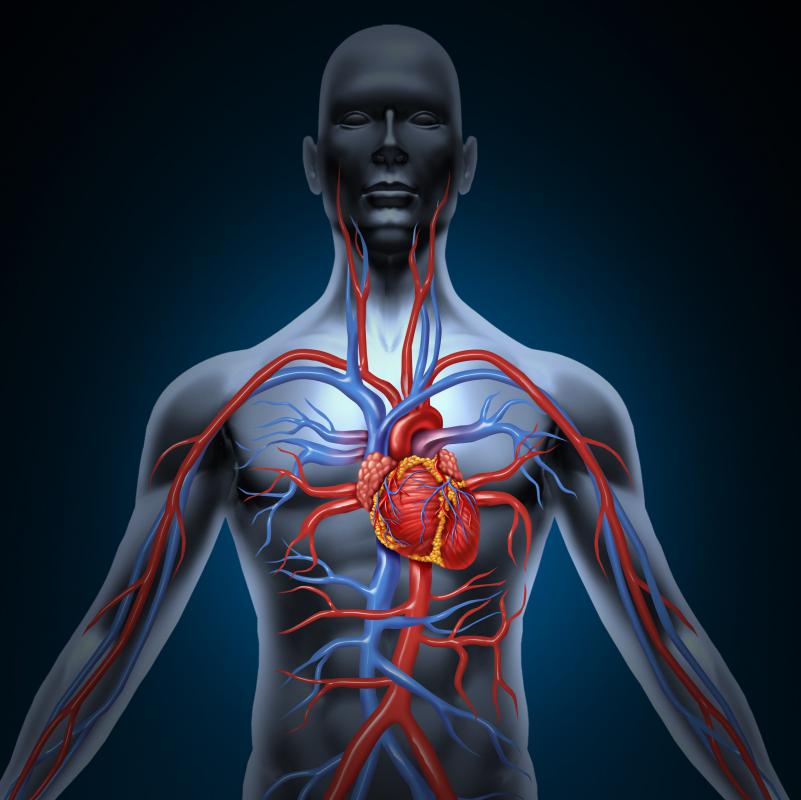At TheHealthBoard, we're committed to delivering accurate, trustworthy information. Our expert-authored content is rigorously fact-checked and sourced from credible authorities. Discover how we uphold the highest standards in providing you with reliable knowledge.
What is Calcification?
Calcification refers to the buildup of calcium or calcium salts in tissues where it does not belong. This often results in the hardening of the tissue, which can have unpleasant or dangerous results. It is most common for calcification to occur in the breast tissue, in the aortic valve of the heart, and in the coronary arteries. Tissue which is dead or degenerated can also be affected by calcification.
In breast tissue, calcification is a relatively common process characterized by the formation of calcium deposits. This can be caused by simple aging, inflammation, or by a foreign object in the tissue, such as implants or sutures. Two main forms of calcification happen in breast tissue: macrocalcifications and microcalcifications. The former are commonly a result of the degeneration of breast tissue that occurs with age, and are not usually a cause for concern. These deposits are coarse in texture, generally presenting in women over 50 years of age.
As their name suggests, microcalcifications are smaller calcium deposits. These small deposits aggregate together into clusters, and may be an indication of breast cancer. Most other forms of calcification take place in the heart.

The valve leading to the aorta from the heart is particularly susceptible to calcification. It was long thought to be a harmless condition, but later research suggests that it may be an indication that the patient already has heart disease, even in the absence of other symptoms. In the early stages, the functioning of the valve itself is not significantly impaired, but it often causes an audible heart murmur. Advanced aortic calcification does affect the valve, and can do so to the degree that it can cause chest pain or even a heart attack.

Calcification can also occur in other areas of the heart, such as in the arteries. In this case, arterial plaques become covered in calcium deposits which form a brittle outer layer over the plaques. Older adults are the ones most susceptible to calcification of this variety, particularly when they already have significant risk factors for heart disease. Some tests can measure the amount of calcium that is present in plaques, but these tests are relatively new and are seriously limited on their own.

Less-common forms of calcification can occur in almost any area of the body. Dystrophic calcification refers to that which occurs because of mineral deposits not caused by an elevated calcium level in the tissue as a whole. Conversely, when measured calcium levels are elevated in a tissue, the calcium which precipitates out forms what is called a metastatic calcification in otherwise normal tissue.
AS FEATURED ON:
AS FEATURED ON:















Discussion Comments
I'm taking a vitamin D hormone right now for this. I went to the doctor several months ago. I had a lot of pain at my knees and my skin was itchy. My eyes were red a lot too. I honestly couldn't make any sense of what was going on.
It turns out it was calcification because my PTH hormone was not working right. This is the hormone that maintains calcium levels in the body. The vitamin D I'm taking helps this hormone work correctly.
I'm feeling better now, but I have to keep taking it.
@turquoise-- Yea, you are right. It means that there is too much calcium in the blood. Not just calcium, but phosphorus as well.
My doctor said that these two always work together and if the balance is off for some reason, you can have problems like calcification (too much calcium and phosphorus) and weak bones and joints (too little calcium and phosphorus).
I'm not sure, but it might not necessarily mean that you are eating too much calcium. The doctor can do some tests to figure out why the calcium and phosphorus is out of balance.
Does calcification have something to do with how much calcium we consume? Does it mean that there is too much calcium in the blood?
Could you list out what are the things that leads to hyperplasia and is there anything you could do to prevent or curb the growth?
Post your comments